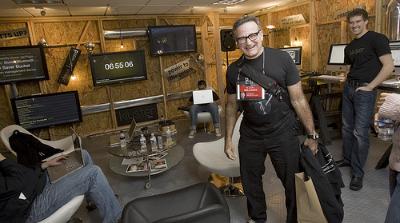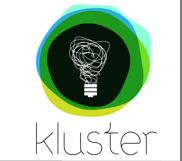Kluster Sets Launch Plans for Open Source Knewsroom.com

A three-minute presentation slot at the annual TED Conference is considered a coup, but that didn't suit serial entrepreneur Ben Kaufman. You couldn't have asked for a more auspicious debut – call it a cotillion for the Digerati. But Kaufman requested -- and got -- more for Kluster: a room of his own to mount 72 Hours – the ideation and rapid prototyping of a concept from inception through implementation, leveraging the entire TED community and its Web-connected global outliers. While the educational board game Over Therewas ultimately realized, 72 hours prior Kaufman had absolutely zip -- zero idea what outcome stood on the horizon. And that's the way he likes it. In an exclusive interview with JackMyers Media Business Report, Kaufman explains the Kluster model and we explore how its architecture can -- and should -- influence a way forward not only for customer collaboration, but more broadly how projects and goals of any scope can be structured and evaluated.

What I Did On My Summer Vacation
While still in high school, eighteen-year-old Kaufman had an idea for an iPod accessory. It was an instant success and enabled him to launch Mophie, an entire product line of iPod add-ons. When Kaufman made his second appearance at MacWorld, (after winning Best of Show his first year) he had an epiphany. He proffered "The Illuminator Project" – asking attendees to submit ideas for the next big thing. Within four hours, he recalls, there were 120 working concepts. The MacWorld community spoke -- 30,000 voted for the best ideas -- and in a matter of weeks three products were put into production. Seventeen-year-old Jared Fiovorich created Bevy-- a combination bottle opener and keychain embedded in an iPod Shuttle case -- and the product was launched on CNBC. The success of Bevy made it clear to Kaufman: "It was our process, not our product." He soon decided that he didn't want to be in the iPod accessory business and sold Mophie for an undisclosed sum last summer, plowing back the proceeds into Kluster.
But just what is Kluster? If, as Malcolm Gladwell wrote, the Tipping Point was the "biography of an idea," than Kluster is its incubator. Kluster marries heart and mind by creating a hybrid -- a social network for idea creation that leverages its algorithmic infrastructure to assess, track, and empower collaboration. In this sense, then, Kaufman is Steve Jurvetson crossed with Mark Zuckerberg.
Under the Hood
The basic unit of currency is the Watt. Upon registration, Kluster allots a member 1,000 watts; more can be earned in myriad ways: inviting others to join, investing in ideas that are eventually "graduated," and through participation -- contributing "sparks" -- or proposed solutions and "amps" -- tweaks or refinements. Every single project on Kluster -- whether it's a Manzier(yes, Frank Costanza's bra for fleshy men was a recent project here) or developing a new prototype for digital music distribution -- is broken down to its elemental parts of production -- they are here called phases.
Everything in Kluster is timed -- the project manager decides on whether each phase lasts hours, months, even years -- and the inflection point, when a concept gets traction, is of particular concern. Even gaming the system has been taken into consideration -- it can identify which users are connected, if they're conspiring in a bloc. Ideas are either "backed" -- which is to say that there is a project-based reward (Bevy's designer got $5K for his efforts) or it is bootstrapped -- where community members may invest their watts in exchange for a stake of the project's proceeds when it is completed, with Kluster owning the IP (and receiving a percentage of reward fees). Asked if this makes the contributions work for hire, Kaufman asserts that this is "the only way this is going to work. You own the UI until the community validates it." While an occasional episode of seller's remorse is inevitable, Kaufman emphasizes "the bottom line is that we're here to get ideas out into the world," adding that "the best protection IS a community. They are investing time, energy, and reputation in seeing something come to life.
Is the social network layer relevant? "Absolutely, we're banking on it. The human element is key. People say "yes" or "no" and validate an idea -- emotionally risking their reputations. Go on the site and define interest, experience, click on "branding" for example and retrieve anyone with that experience. Look at their portfolio and history." Indeed, one's homepage resembles Facebook's Mini-feed. Here you can see "props" they've left for peers, sparks or amps towards a project, watts invested. But rather than Facebook Beacon's glimpse into a pattern of purchases, you have a holistic snapshot not merely of consumption, but of action.
In a sense Kluster is a 21st century version of Eames Office, run by industrial designers Charles and Ray Eames, staffing up based on the needs of a wide array of projects from museum installations, films, or architectural undertakings. There, too, process was key. Asked to contrast Kluster with Current TV's system of bubbling up the best video projects for broadcast, Kaufman expresses admiration, suggesting that a key difference is (beyond their core businesses) Kluster's reporting system: "We're a little bit more mathematical, algorithmic, and analytical, which could be good or bad."
The median age range of Kluster is thirtysomething, a surprise to Kaufman. He's finding that retirees and housewives are participating -- unleashing either ideas of their own that had nowhere to go, or iterating on concepts based on interest and/or experience. While a board game designed to encourage cultural awareness is a nice takeaway from TED, the conference gave him a more profound outlook: "It got us to reassess whether we only want to run projects with organizations, sponsor them within Kluster, or engage the community on our own terms as well. We don't know exactly what we are and we love that. There are three different directions we can go in: Private label community -- "Powered by Kluster; allow small businesses to run projects, be they marketing, campaigns, or events; but the most exciting piece is to structure this community in the sense that we have a series of brands, a working group. I prefer the latter, but we going to try all three."
This week Kluster is launching Knewsroom. Coming out of TED, Kaufman and Bo Peabody (Kluster Board Chairman, founder of Tripod.com and VC Village Ventures) looked at the popularity of news aggregation and settled upon creating a daily media publication that is entirely consumer-operated, applying Kluster's architecture to a traditional format. The consumer will decide on content, on advertising, everything including whether it's printed or online. Pressed that such anarchy could realize either a product centered around the Dalai Lama or the cult of L. Ron Hubbard for that matter, Kaufman is unfazed. "It's an experiment. We had the idea a week ago and BAM. It costs us nothing to run, to put together. As long as the community is using it, there will be no reason to take it down. It represents the first among a series of community-owned and operated brands under the Kluster umbrella. Every decision is in the hands of the community." In theory you will have the most democratic of papers, supported by the most loyal readers.
But don't get the impression the Kluster is amateur hour. Its algorithm, like its projects, is goal-oriented: "Everyone should understand that communities can be diverse. Qualified and unqualified participants are welcome. Mathematically, we are credentialing, letting everyone in. We provide specific goals and everything else happens organically."
Kluster's broad architecture can be leveraged in all decision-making activity. On the site folks are in the middle of a three-month project to create a black box that anticipates/enables the future of the cell phone industry; recently completed Napkin 2.0allows VCs to assess capacity of personnel and balance risk/reward. Others still are working on collaboration dispute resolution as an alternative to litigation. Products, then, range from the social, political, commercial, even to the environmental.
While every entrepreneur aspires to take their company public, such talk is premature to Kaufman: "My focus is to simply empower groups to make decisions and collaborate. If I'm successful, other doors will open." Kluster.com archives a half-dozen videos, including the pitch that secured their TED invite. At the end of that clip, adlibbing in the background, a staffer blurts, "Everything comes together." This is the soul of Kluster.
For further information on Kluster contact: Tiffany Markofksy at Tiffany@Kluster.com.


